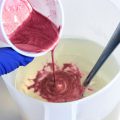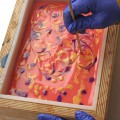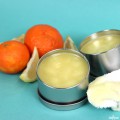
Click here for day one – lip stick colorants
When making lipstick, there are a lot of different ingredients you can use. The basic ingredients are covered here but there are many, many more exotic oils, waxes and butters that can be used in lipsticks.
Wax – Waxes can be beeswax, candelilla wax, jasmine wax, orange wax and ozokerite wax. Most common to the home crafter is beeswax because of its pricing and easy availability. For vegans, candelilla wax is the preferred alternative since it is derived from a plant. Waxes are used to help provide a barrier against the elements, seal moisture in the lips and keep color on your lips. Waxes also help to provide shape and form to the lipstick mixture.

Oils – Oil in lipstick are used to be moisturizing, help provide a barrier against weather and also mix with the waxes to form a smooth, spreadable mixture. Popular oils in lipsticks are Sweet Almond Oil, Avocado Oil, Olive Oil and Hempseed oil. There are many other liquid oil options to use. It’s fun to play around with exotic or lesser known oils but remember, if your lipstick really takes off in the market, you want to make sure that the oils you choose are easily available and cost effective.
Butters – Butters are used in much the same way as oils are. They are designed to moisturize, help protect and make a stable mixture that is solid at room temperature yet glides and melts on the lips. Common butters in lip balm recipes are Shea Butter, Mango Butter and Cocoa Butter. Generally, large brands of lipstick do not use butters in their formulations. Since butters are comprised of many different fatty acid chains, they are described as “polymorphic,” which means that they have the ability to crystallize in several different forms according to how the liquid fat is solidified. What this means to you is that butters must be treated with gentle loving care in lipsticks. You need to melt them slowly (temper them) and then immediately place the finished product into the freezer for quick chilling. This will help to minimize any crystals that might form hard, unsightly bumps in your final product. Or, you can do what the “big guys” do and just avoid butters all together.

Lip Safe Fragrance – Lip Safe Fragrances are commonly referred to as “flavors.” They are not the traditional alcohol based flavors or extracts in the grocery store. While fragrance oils have up to 3500 different ingredients that can go into them, less than 10% of them are classified as safe for lips. This is because you “eat” your lipstick so anything that goes onto your lips must be GRAS (“generally recognized as safe” as classified by the FDA). Flavor oils, or lip safe fragrances, do not taste like anything. Rather, the user is tricked into believing that the lipstick or lip balm “tastes” because they inhale the scent. Seventy-Five percent of what we taste is actually from our sense of smell.
Before you get started, gather your equipment and ingredients.
Equipment Needed:
droppers
knives
spoons
small glass jars (microwaveable)
chapstick tubes/or lip pots
lip safe colorants
beeswax or another wax
liquid oil (sweet almond oil, hazelnut oil, jojoba oil – it’s your choice)
lip safe flavor





So, I’ve started making my own lip colors and just love it. However, I’ve seen people say to grind the micas and oxides. Is this necessary when create lip products? How does one go about doing this? Sorry, I’m a total newbie at all this.
I think people do that just to create a finer mica. I don’t ever grind micas when making colored balms. It’s a personal preference thing. Just make sure you’re using lip safe micas.
Courtney from Bramble Berry
Yes, you can sub any liquid oil for another liquid oil without much change in the final product. You may notice a slight difference if you're doing a very light oil (like Grapeseed Oil) versus Jojoba Oil (a heavy liquid wax) but in general, the subs will work out great.
I'm so glad that you like the recipes on this blog. My whole goal is to educate you enough so that you can make the product yourself, easily at home. =)
Can any wax or oil be substituted for another one? Like in your lipstick recipe you say to use 4 oz. jojoba oil, could I use avocado oil, sweet almond oil, etc. instead?
Thank you so much for doing all these posts about lipstick making! All of the information is extremely helpful. Most places just post a recipe and don't explain about all of the ingredients and such in depth info about the process. Your posts have given me the confidence to actually do it instead of just reading about it. Thanks!
Can any wax or oil be substituted for another one? Like in your lipstick recipe you say to use 4 oz. jojoba oil, could I use avocado oil, sweet almond oil, etc. instead?
Thank you so much for doing all these posts about lipstick making! All of the information is extremely helpful. Most places just post a recipe and don't explain about all of the ingredients and such in depth info about the process. Your posts have given me the confidence to actually do it instead of just reading about it. Thanks!
FTR, I think it is a myth that such a great percentage of our sense of taste is actually smell. I was able to smell until I was 27 years old and now, having been anosmic for ten years I can taste just fine. Some things (like basil) have very strong scents and not a lot of taste but a person who can smell wouldn’t know that.
Other things, like the classic “compare an apple, onion, and potato in taste with your nose plugged and you can’t tell them apart” experiment doesn’t work at all for me. They taste completely different! I think our taste compensates eventually for the lack of smell so maybe for people who usually smell can’t tell those things apart but for me, not smelling for so long, my ability to taste has overcome the lack of smell.
I use fragrance in my soaps and lotions and butters, but I have to rely on my family’s noses for amounts and then write down the precise amount, following it like a recipe the next time.
I can easily tell a commercial lip balm from a homemade one because the commercial ones nearly always have some sort of sweetener added and homemade ones usually don’t.
Hi Patti – Great! I can’t wait to get your report on making lipsticks. It’s a new kit for us so I am sure there are things that we can improve on with the instructions and the like so definitely report back on what you think of the kit.
I ordered the kit yesterday, and can’t wait to get started. Sounds like so much fun. I also love the idea of knowing what goes into the lipstick I “eat”!
I am looking forward to putting a little color into my lip products.
Michelle in NV
Cool. I can’t wait to try this. I have almost everything you have mentioned. Jessica